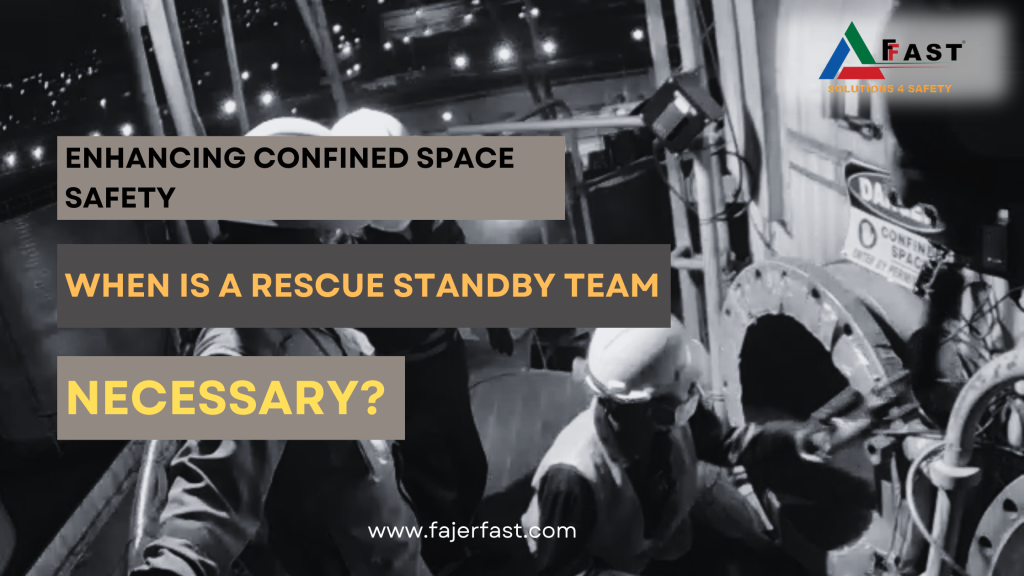Confined spaces present unique challenges and hazards that can pose a significant risk to workers’ safety. Due to their limited entry and exit points, restricted ventilation, and potential for hazardous substances or engulfment, confined spaces require careful planning and precautions to ensure the well-being of those working within them. One crucial aspect of confined space safety is the presence of a rescue standby team. In this post, we will explore when and why you need a rescue standby team for confined spaces, emphasizing the importance of proactive measures to prevent accidents and effectively respond to emergencies.
1. Definition of Confined Spaces:
To establish a common understanding, let’s define confined spaces. Confined spaces are areas with limited access and egress, not designed for continuous occupancy. These spaces often have restricted ventilation, making it challenging for workers to escape in the event of an emergency.
2. Recognizing Confined Space Hazards:
Understanding the potential hazards associated with confined spaces is essential for determining the need for a rescue standby team. Hazards may include toxic or flammable atmospheres, oxygen deficiency or enrichment, physical obstructions, excessive heat, noise, vibration, or the potential for engulfment.
3. Regulatory Requirements:
Various regulatory bodies have established guidelines and regulations concerning confined spaces, including the need for rescue standby teams. Familiarize yourself with relevant standards, such as OSHA’s Permit-Required Confined Spaces (29 CFR 1910.146) in the United States, and ensure compliance with these regulations.
4. Assessment of Confined Space Hazards:
Before assigning a rescue standby team, a thorough assessment of confined space hazards must be conducted. This assessment should involve identifying potential risks, evaluating atmospheric conditions, analyzing the presence of toxic substances, and assessing the likelihood of engulfment or entrapment.
5. Determining the Need for a Rescue Standby Team:
Several factors influence the decision to have a rescue standby team present during confined space entry:
a. High-Risk Tasks: If workers are engaged in high-risk activities, such as tasks involving hazardous substances, welding, cutting, or working at heights, a rescue standby team is crucial.
b. Complex Entries: Confined spaces with intricate entry and exit procedures, convoluted pathways, or limited visibility may require a rescue standby team due to the increased likelihood of workers becoming disoriented or trapped.
c. Unknown Conditions: When the conditions within a confined space are uncertain, such as after a spill, flood, or equipment malfunction, it is advisable to have a rescue standby team available to respond quickly in case of an emergency.
d. Non-Standard Configurations: Confined spaces with irregular shapes, restricted openings, or confined spaces that have been modified, may necessitate a rescue standby team to assist with extrication.
e. Prolonged Entries: If workers will be spending an extended period inside a confined space, a rescue standby team should be on-site to monitor conditions and be prepared for emergencies.
6. Roles and Responsibilities of a Rescue Standby Team:
The rescue standby team’s primary responsibility is to provide immediate assistance in the event of an emergency. They should be adequately trained in confined space rescue techniques, first aid, and the use of specialized equipment. Their roles include monitoring atmospheric conditions, maintaining communication with workers inside the confined space, and executing rescue operations if needed.
Confined spaces pose inherent risks to workers, and the presence of a rescue standby team is crucial to ensure their safety. By recognizing confined space hazards, complying with regulatory requirements, conducting thorough assessments, and considering various factors, organizations can determine when it is necessary to have a rescue standby team present. Prioritizing safety and taking proactive measures will help prevent accidents, mitigate risks, and ensure effective responses to confined space emergencies.
FFAST offers tailor-made rescue operations with a highly skilled and professionally trained rescue team who can effectively equip the emergency situation needed. By helping protect your workers in emergencies, we help reduce hindrances and increase efficiency. We also offer emergency rescue training as part of our rescue services.
